Dear reader: This article contains links to products and services that I may be compensated for, at no extra cost to you.
After living in Taiwan for over 10 years and exploring the country inside and out, I finally decided to visit Cingjing Farm (清境農場 or Qingjing Nongchang) in the high mountains of Nantou county. It is one of the country’s most famous family-oriented tourist attractions.
Honestly, my expectations were quite low. I’d already researched the hell out of it, seen the pictures, and advised numerous travelers on how to get there in my Taiwan Travel Planning group.
Still, I enjoyed Cingjing Farm even less than I’d imagined.
Later, I did a poll in my group and the masses agreed – group members voted Cingjing Farm as the most overrated attraction in all of Taiwan.
In this article, I’m going to explain what I didn’t like about Cingjing, but also some redeeming factors (like visiting nearby Hehuanshan!), so that you can decided whether you should bother going there. I’m going to describe the pros and cons of Cingjing Farm, then give a detailed personal account of my entire visit.
If you’re looking for all the practical details, like when to go, best tours, how the Cingjing Pass works, how to choose the right hotel (super important, due to the landscape and long walking times in the area), then please see my guide to visiting Cingjing Farm.
Table of Contents
What is Cingjing Farm?

Cingjing Farm is one of the most popular and famous tourist farms in Taiwan, and the country has many of them. This one actually has some interesting history behind it. After the Chinese Civil War, a group of KMT soldiers, mostly from the Shan and Dai tribes in Yunnan province in China, were settled in this remote high mountain location.
It was them who first started the farm, but the farm only took off as a major tourist attraction after Highway 14 was constructed, connecting it to Puli and Taichung to the west and Hualien and Yilan to the east.
The farm was first build in a European-style, complete with castles and windmills. This Europe fad was very common for theme parks in Taiwan in the 80s and 90s (and still sometimes today). Locals consider a European-style farm as very exotic, since they don’t have those.
But European or North American visitors may find it unusual and fake feeling.

Besides the farm’s official accommodation, an aging establishment now mainly used by elderly tour groups, there are now dozens of other guesthouses in the area, making it one of the most popular mountain resorts in Taiwan.
Cinjing is often billed as magnificent, with local expressions like “Roof of Taiwan” (台灣屋脊), Forest of Eden” (伊甸園), and “Peachland above the mist” (霧上桃源).
Indeed, the mountain scenery around Cingjing is beautiful. But this is certainly no “eden”. It is a super touristy attraction with outdated facilities revolving around a fake farm.
Cingjing Farm Pros and Cons
So Cingjing Farm isn’t all bad. Probably your experience of it is going to depend largely on where you come from.
If a cow and sheep farm sounds fascinating and exotic to you, and you aren’t used to cold weather or mountain scenery, then you may find it quite appealing. If you grew up with farms, mountains, and cold weather like I did, then you may be severely disappointed by the farm itself, but still enjoy the surrounding area.
So here’s a list of the good and bad parts of Cingjing Farm, all based on my personal opinion and nothing more.
Pros
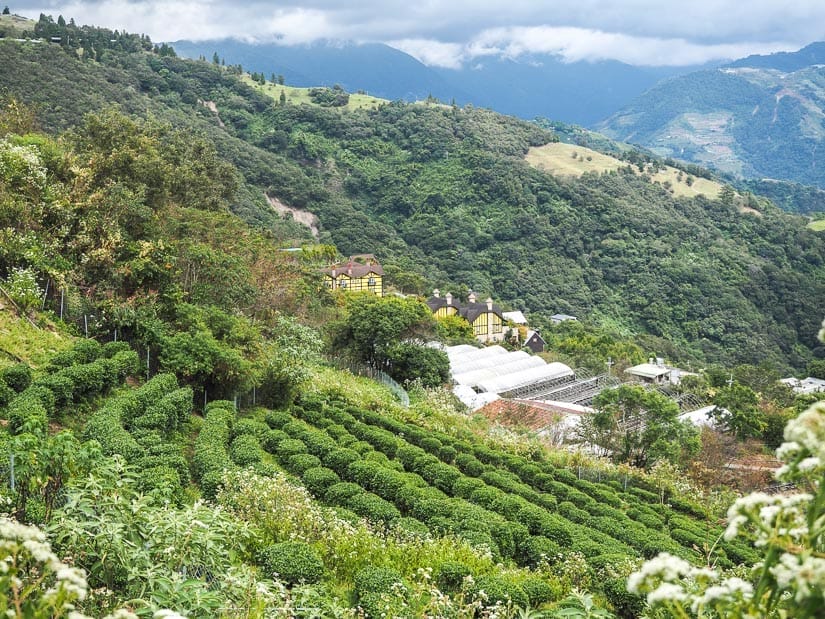
- The mountain scenery around Cinging is stunning (but you can say that about 2/3rd of Taiwan).
- There are cherry blossoms blooming at Cingjing Farm in February. On a clear day with blue skies during cherry blossom season in Taiwan, Cingjing Farm is at its most beautiful.
- There are some truly excellent guesthouses around Cingjing Farm (don’t stay in the official accommodation though).

- If you are from a tropical country and have never seen a Western style farm before, you can do it here without going all the way to Europe (but heads up, this isn’t authentic in any way).
- Cingjing Farm is a good base for exploring Hehuanshan, which is an incredible hiking destination. There’s only one hotel at Hehuanshan (Songsyue Lodge) and it’s very hard to book. See my Songsyue Lodge review for info on how to book it. If you’re hoping to see snow in Taiwan in January or February, nearby Hehuanshan is the best place to try (still not guaranteed though!)
- Due to the elevation, the air is cooler there, so it’s nice to visit in summer.
Cons

- If you come from anywhere that has lots of European or American style farms like I do, the farm itself will not be impressive to you. The main animals you’ll see are sheep and horses, that’s it. Many other leisure farms in Taiwan have a wider variety of animals, with less walking to see them (for example the very popular Zhang Mei Ama’s Farm in Yilan or Flying Cow Ranch in Miaoli).
- Even though it’s called “Green Green Grassland”, the grass didn’t even look nice to me. But I am spoiled by living in the prairies of Canada.
- The farm facilities are super outdated. They look like they were built in the 1970s and have not been renovated and changed since.
- The side attractions like Swiss Garden and Carton King are especially crappy and outdated. Don’t waste your money on them.
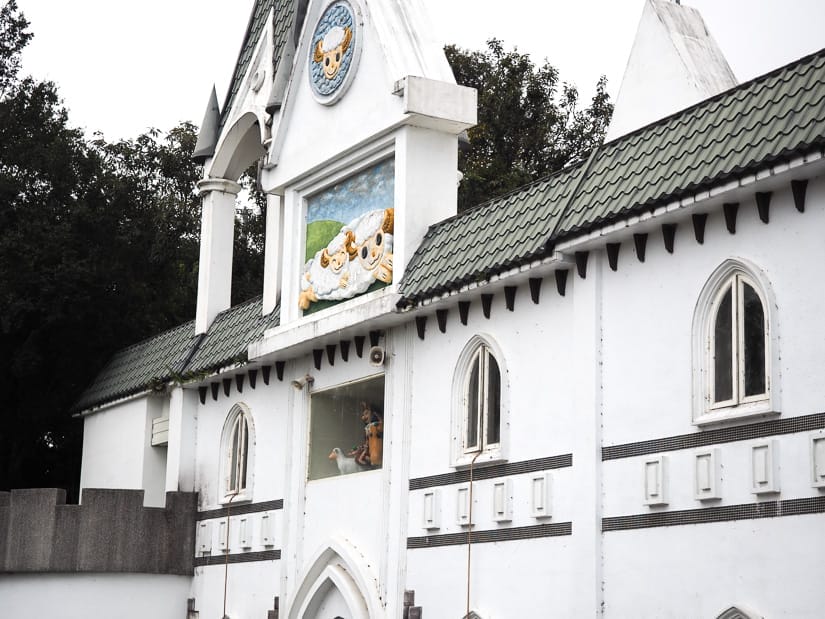
- During the famous sheep shearing show, I felt like the animals were not treated well. I didn’t enjoy watching the show. More details on that below.
- The sheep shearing shows only happen on weekends, holidays, and July/August every day except Sundays. (Horse shows are every day, though).
- The European-style castles and buildings are weird to see in Taiwan. This may seem cool or exotic to visitors from Asian countries, but for me it all feels so fake.
- Cingjing Farm is famous for clouds/fog, so it’s possible you won’t even be able to see the mountain scenery well (this happened to me).

- The park is super popular among local and visiting families, so it can be very busy (especially on weekends or national holidays) and the feeling is very touristy.
- Visiting Cingjing Farm requires a lot of walking, especially for parents/children. If you have kids, there are many other tourist farms in Taiwan where you can see more animals with less walking.
- If you like hiking, the hikes around Cingjing Farm are not great. There is far better hiking at Hehuanshan, Alishan, or Taipingshan.
- It can be quite cold in winter. Most hotels provide heaters or heated blankets.
My Cingjing Farm Experience
I’m now going to describe my personal experience visiting Cingjing Farm from start to finish.
Getting There

For far more details than I’ll provide here, including all the bus information, see my guide to getting to Cingjing Farm.
I rented a car in Taichung (I rented here on Klook) and drove to Cingjing Farm and Hehuanshan. I recommend doing this for several reasons. (Note: an IDP is needed – learn more in my guide to driving rental cars in Taiwan).
First, driving allows you to make some small stops along the way. Second, driving takes 1.5 hours while the bus takes 2.5 hours. Third the area around Cingjing Farm is mountainous and takes a long time to get around on foot. It could be a long, steep drive from the farm to your hotel.
Last but not least, there are only 3 buses per day from Cingjing to Hehuanshan, which is very limiting. I wanted to stop at every lookout platform on the way (and there are 3 or 4 great ones), which you wouldn’t be able to do by bus.
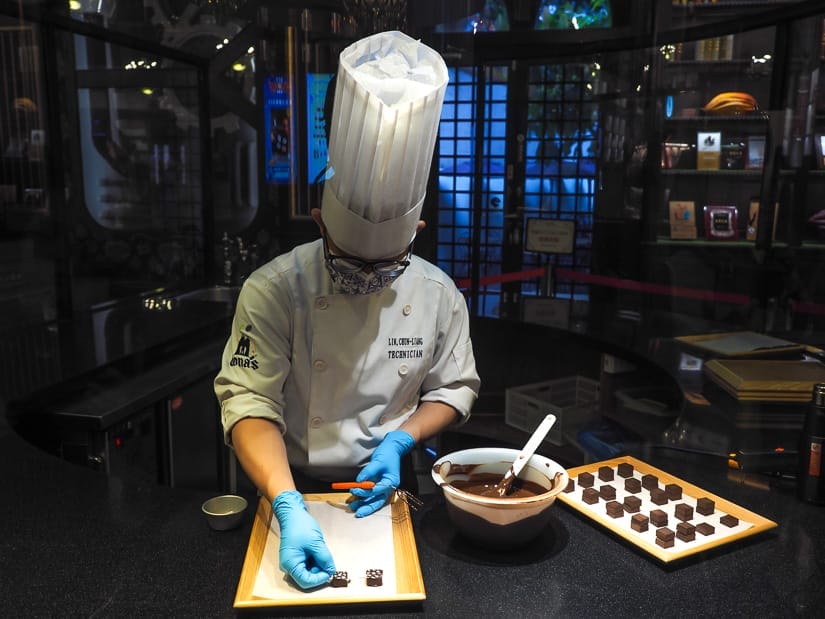
On my drive from Taichung to Cingjing Farm, I stopped at Nina Chocolate Dream Castle (buy tickets here) in Puli. This is a tourist facility with some interesting chocolates and ice cream, but it’s definitely not meant to be a very high end chocolatier.
In past trips I’ve also explored other attractions in Puli, like Paper Dome, Hohocha Tea, Antique Assam Farm, and Chung Tai Chan Monastery. You could also consider visiting any of these on the way. Read more about these places in my Sun Moon Lake guide, as Puli is a gateway to both Cingjing Farm and Sun Moon Lake.
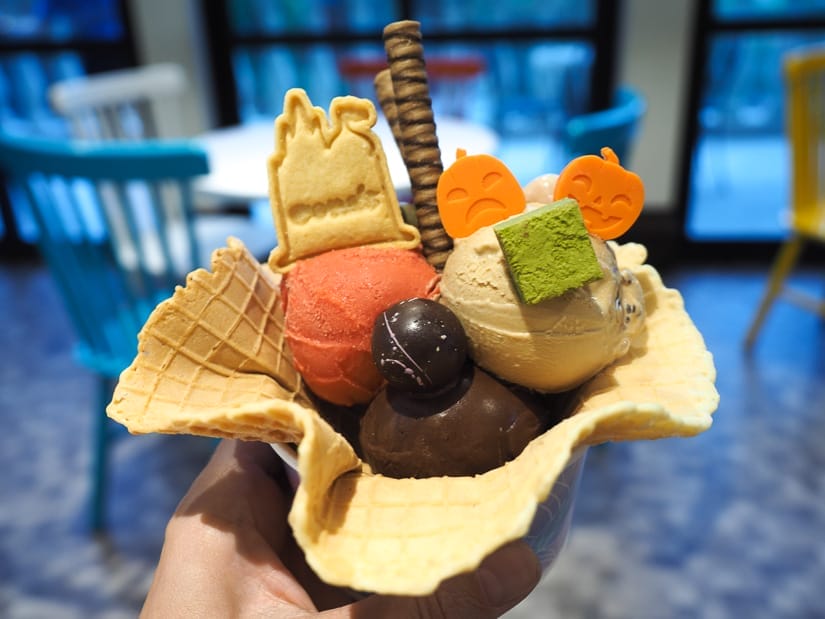
I’ve also hiked to waterfalls on the drive from Puli to Cingjing, like Caidie Falls. Closer to Cingjing, it’s possible to make a small detour to Lushan Hot Spring or a longer detour to Aowanda National Forest Recreation Area (especially recommended for fall foliage in November to December). You can also visit on this Aowanda day tour.
The part of the drive from Taichung to Puli is a flat expressway. But from Puli onward, the drive is very winding.
Arriving at Cingjing
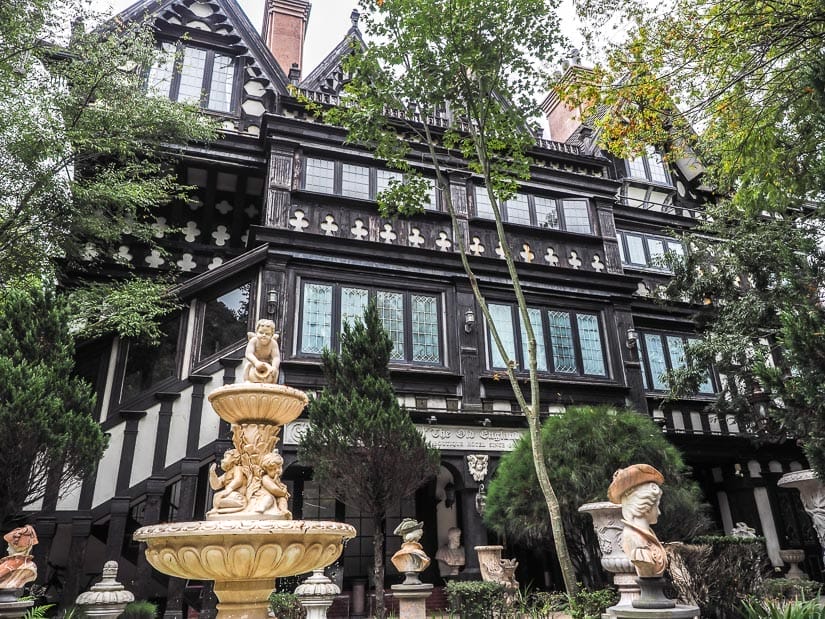
I knew I was getting close when I spotted the first castle-like guesthouse at Cingjing: The Old England Manor (see on Booking / Agoda).
I spent a lot of time researching the landscape and layout of Cingjing Farm before choosing to stay at Iris Farmhouse (see on Booking / Agoda). It’s hard to wrap your head around without actual being there, as the farm and areas around it are all built on mountain slopes.
I decided to choose a place in the region to the south of the farm, where there are many cute guesthouses. It appealed to me because it’s quiet, rural, and I don’t mind the long (mostly uphill) 45-minute walk it would take to get from my guesthouse to the farm’s main entrance.
I also wanted to be close-ish to 7-11 (near Cingjing Guesthouse), a few hiking trails I wanted to try, and the Cingjing sunset viewpoint (we’ll get to all those below).
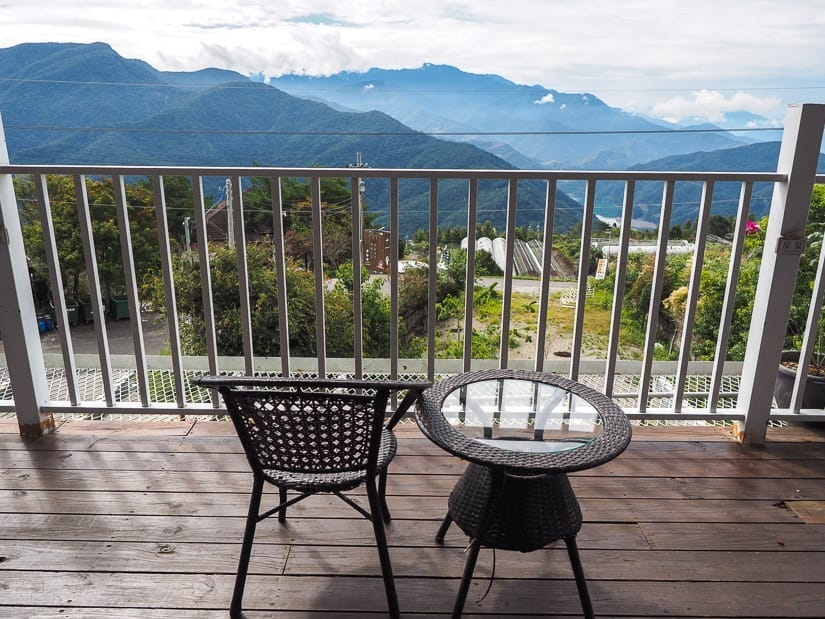
However, if you’re coming with kids and don’t want to walk several hours in one day, then I recommend staying in a guesthouse that’s close to the northern entrance of the farm, like this one or this one. If not, make sure to choose a guesthouse that offers free transportation to/from the farm.
Driving into Cingjing area, I followed the instructions that had been provided by my hotel (they said GoogleMaps would mislead me). I turned off the highway here, just after 7-11 and Cingjing Guesthouse (the large official accommodation.

This narrow, one-car lane leads to several lovely accommodations. Some are surrounded by tea farms and have amazing mountain views. That’s why I chose this area!
I arrived at my hotel too early for check-in, so I parked the car and set out on foot. Yes, I could have driven right to the farm, but I love exploring on foot and I didn’t want to compete with the masses for spots in the parking lots.
Exploring Cingjing Farm and area

From my hotel, I did two of the “eight classic hikes” (八大步道) of Cingjing Farm. This is where I first learned that these “big hikes” mentioned by every Mandarin blog about Cingjing aren’t actually hikes at all. These are mostly just car roads with limited or no signage to indicate it’s supposed to be a “hike”.
The Tea Plantation Trail (茶園步道), which was near my hotel and appealed to me most because I love Taiwanese tea, was merely a 10-minute cement path loop around one small tea farm. Though I admit it did have some lovely views.
After doing that, I walked down to Cingjing Guesthouse, then walked the Qingjing Sakura Trail up the highway. This is another of the “classic hikes”, but is literally nothing more than a boardwalk on the side of the highway so you don’t have to walk on the highway itself. It has a few cherry blossoms in season, hence the name.
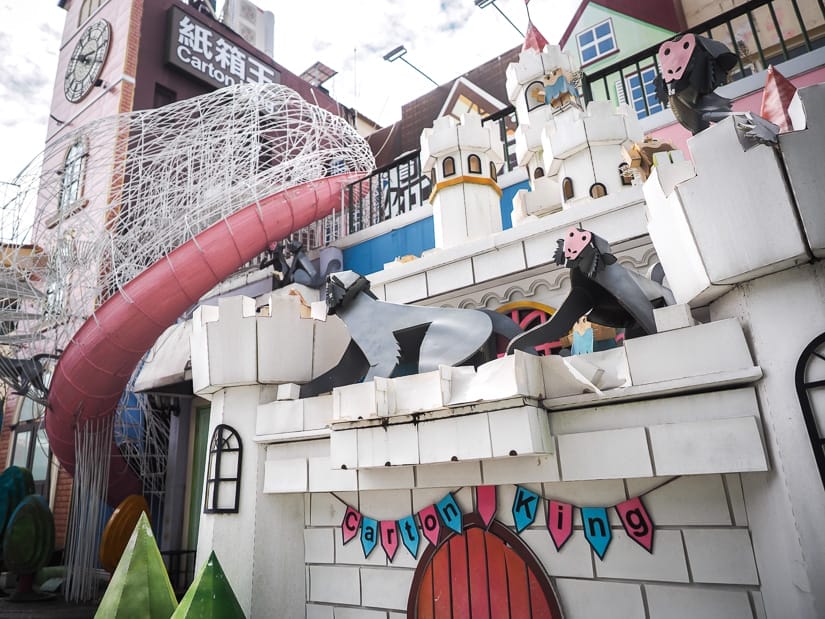
Walking that for 10 minutes (slightly uphill) brought me to Carton King, which is a paper-themed restaurant and children’s playcenter. Everyone mentions this place on their Cingjing itineraries, but I was shocked to find how crappy it is.
Carton King Cingjing is nothing more than one slide, one very small train ride for toddlers, and a restaurant where everything looks like it’s made from paper. The whole thing looks very old. If you have kids, then sure, make the quick stop, but it’s really nothing special.
The Carton King in Taichung city is much better and larger, with more statues, slides, exhibits, a larger shop, better restaurant, and so on. Unfortunately, it’s a ways outside of the Taichung city center, so it’s not easy to get to.

A little further uphill from there, I found the the bottom entrance to Cingjing Farm and Cingjing Skywalk here.
I would figure this out later, but the bottom entrance of Cingjing Farm is practically abandoned, so don’t try entering the farm here. If you did, you’d have to hike up a super long staircase only to find that entrance is abandoned and no longer used.
Instead, I started walking the Cingjing Skywalk here. This is a 1600-meter elevated pedestrian walkway that allows visitors to walk between the three main entrances to the farm. It is separate from the farm, so it has its own small entrance fee (TWD 50 for adults), which is valid for one day (save your ticket).
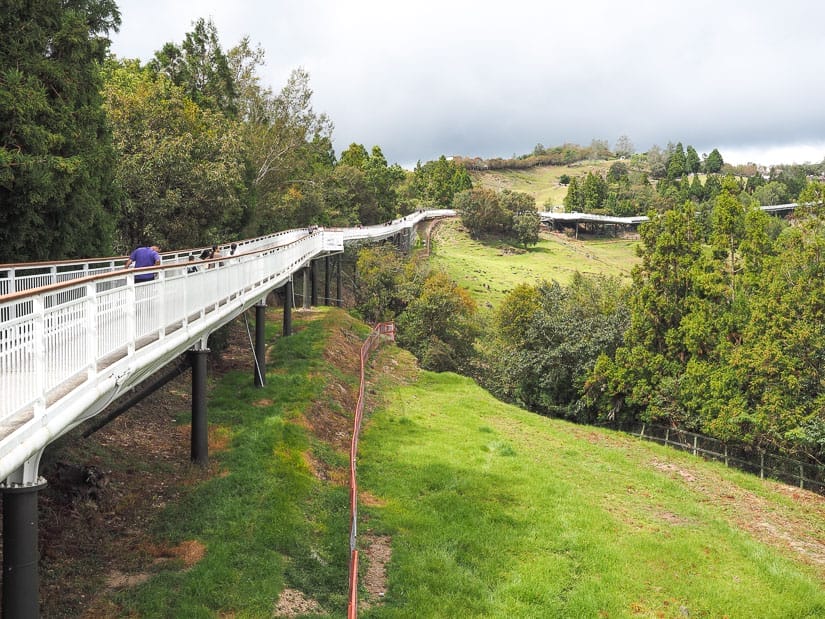
While the skywalk is billed as an attraction in itself, as it does offer some great mountain views, it is mainly just a way for visitors to walk safely instead of going along the twisting highway.
Although the walkway starts on the left (west) side of the highway, most of it is on the right (east) side, offering find views of the valley and mountains to the east.
The walkway was more tiring than I expected, as most of it is going uphill. I saw some moms pushing strollers up and felt sorry for them.
It took me about 20 minutes to reach the middle (main) entrance to Cingjing Farm here. The walkway also continues from there to the upper entrance to Cingjing farm here, but you really don’t need to walk the whole thing unless you want to.

Getting off the Skywalk, I crossed the road to enter the large Cingjing Food Court (清境農場美食廣場), where I had my lunch.
The food court is often billed as a Yunnan food street, but I was surprised to find that virtually all the foods there are common dishes you can find throughout Taiwan. However, one of my readers pointed out that the dishes served there really are common in parts of Yunnan, too.
The main dishes sold at almost every stall were bamboo soup (筍子湯), bamboo tube sticky rice (竹筒飯, which is common in aboriginal communities in Taiwan), sesame oil chicken (麻油雞), boar meat sausages (山豬肉香腸), and slabs of tofu stuffed with pickled veggies and peanut powder (豆腐包).
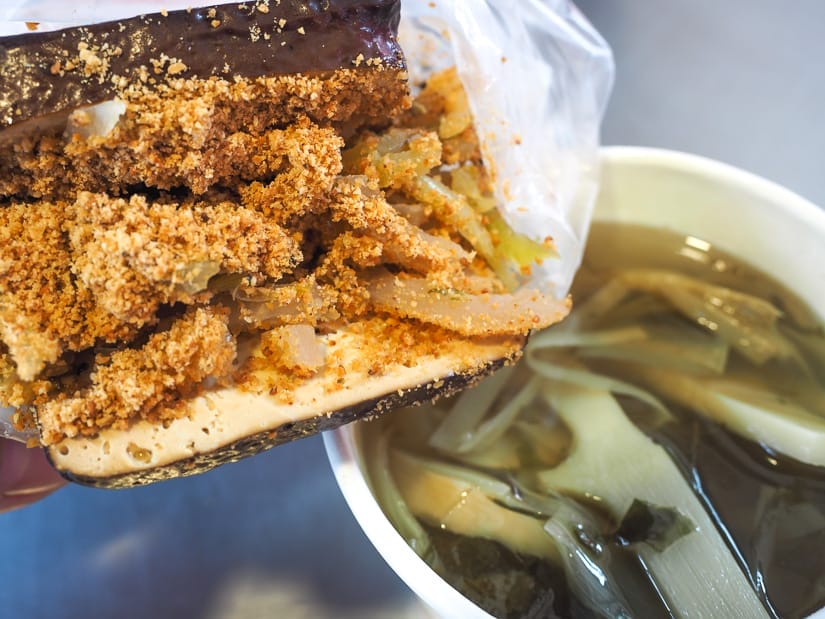
The food court occupies a sort of middle ground between the upper and lower areas of Cingjing Farm. You need to turn right and go through a ticket booth for the upper area , or follow a hallway of food stalls at the back left to the lower area.
No matter which area you enter first, it’s important to stamp your hand (you have to do it yourself), for when you’ll later move between areas. The entrance fee is TWD 200 per adult.
I turned right to the upper area first because I wanted to see the famous sheep shearing show. The show takes place twice per day (9:30 AM and 2:30 PM) on weekends, national holidays, and every day except Wednesdays during winter and summer holidays, including all of July and August.

The upper area of Cingjing, between the middle and upper entrances, is called Green Green Grassland (青青草原). This is the most famous part of Cingjing Farm, and sometimes the whole farm is referred to with this name.
This area has the farm’s signature rolling grassy hills, which all the Mandarin sites will describe poetically. But coming from Canada, they are really nothing special. My backyard in the city in Canada has nicer, greener grass than Cingjing Farm.
But apparently for Taiwanese and many visitors from tropical Asian countries, they aren’t used to seeing large fields or hills with grass, so this may be special.
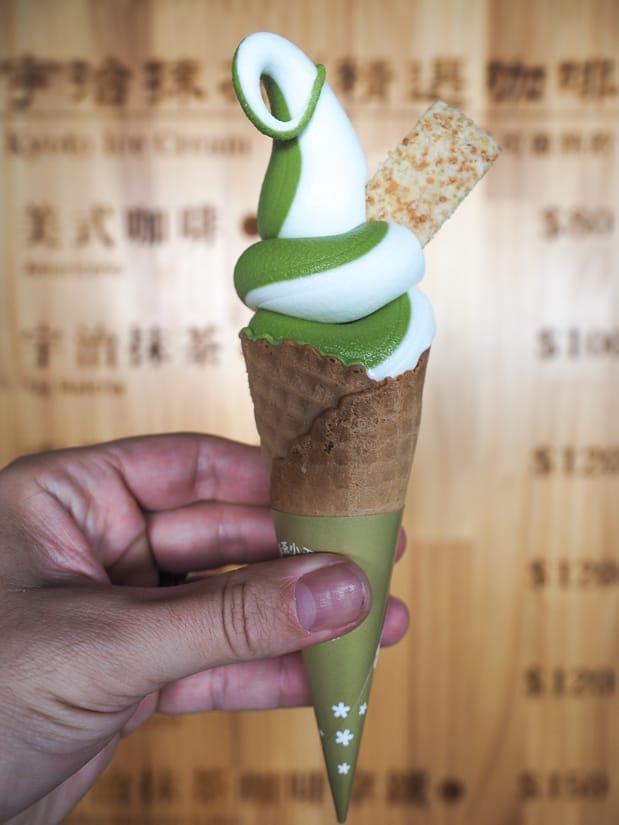
I had budgeted over an hour for Green Green Grassland, but after 15 minutes, I’d walked every trail there and I was bored. There were hundreds of tourists, but hardly any animals to be seen. I walked to the top to see the old, ugly white castle at the northern entrance. The Sheep Story House (綿羊故事館), a very small museum about sheeps, was closed.
The most exciting part for me was this delicious matcha ice cream cone I found from Matcha Prince (抹茶小王子) in a small pavilion with a few shops in the middle of the grassland.
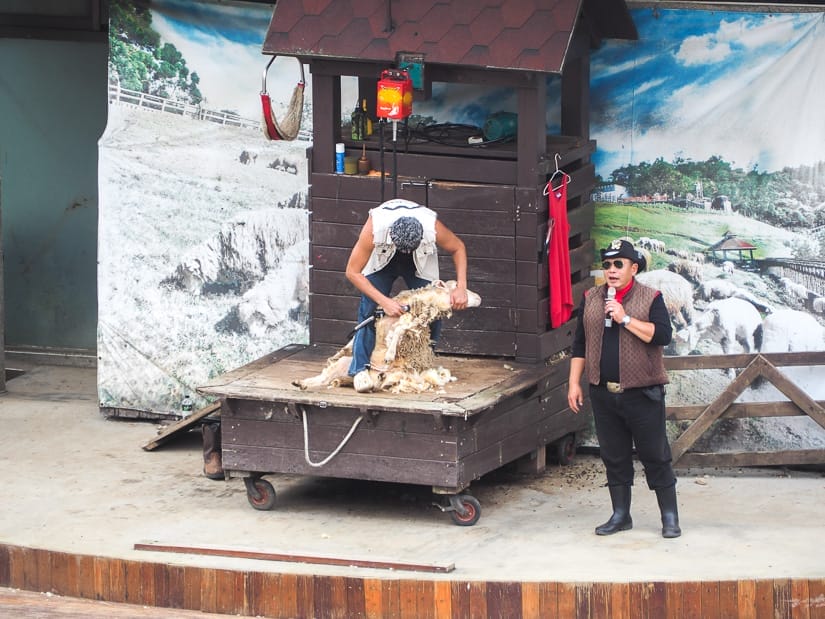
When the sheep show came on here at 2:30, hundreds of people (virtually every visitor at the farm) were gathered for it.
The show was all in Mandarin. To start, the crowd watched as the sheepdogs displayed their skills moving the sheep around on the grassland and then back into the pen, barking at and biting them to control them. This was actually impressive to see.
Next, the presenter talked for a while as one guy sheared a sheep on the stage.
Now, I confess that I am a city slicker and a long-time mostly vegetarian. But I’m realistic and don’t judge others for their choices. But it honestly looked like the guy was being more aggressive than he needed to be with the sheep. I felt like he was being unnecessarily rough with it to please the crowd.
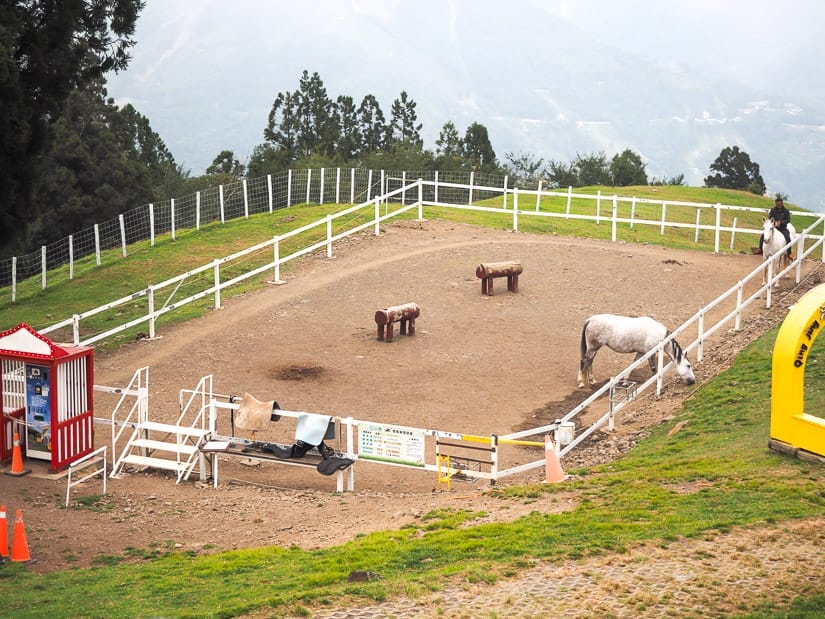
That was enough for me, so I took off to beat the crowds and visit the other parts of Cingjing Farm. I returned to the middle food court area, then entered the lower area of Cingjing Farm here, called Guanshan Pasture (觀山牧區).
This area was much quieter (probably because everyone was watching the sheep shearing show), so I did like it a little more. There wasn’t really much to see, though.
I saw a few windmills, a few roaming sheep, and a pony riding pen where a sole staff member waited for clients.

Further down, I found the site of Cingjing Farm’s other main show, the Equestrian Show. This one is supposed to take place every day at 10:45 AM and 3:45 PM, timed right after the sheep shows so that visitors can easily see both. I was more looking forward to this one, as the horsemanship of the riders is supposed to be quite good.
Except I found that the Equestrian Theater was closed and undergoing major renovation – yet another major disappointment in my visit. I have since contacted the farm and they confirmed that the horse shows are now running again.
I decided to follow the trail all the way to the end, to the lowest section, labeled Shoushan Park (壽山園) on maps of the farm. It was here that things got a little spooky. The area has abandoned vibes.

I found a small trail, totally overgrown with vegetation, which led up a staircase to a large Chiang Kai Shek statue (keep in mind that the farm was established by KMT soldiers, and CKS was their leader).
Judging by the amount of leaves and twigs on the stairs, I don’t think anyone ever comes up here!

From there, I followed stairs down the other side to the Lower Entrance of Cingjing Farm. This entrance seems totally abandoned and had no staff, although it did have a functioning restroom.
I was able to exit the farm gates here, but due to the turning gate, I don’t think you could enter here. This is why earlier in the article I mentioned that you should not try to enter Cingjing Farm here.
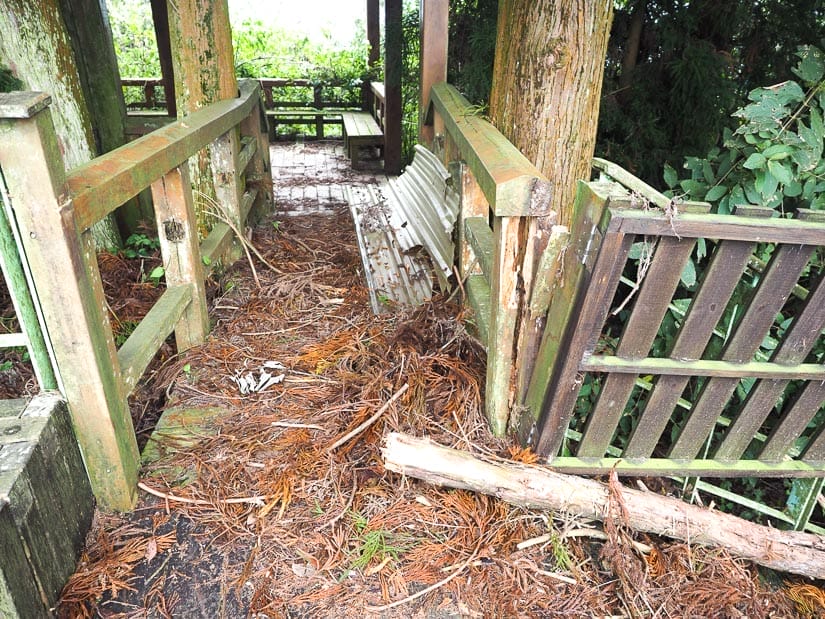
After exiting, I walked down 487 stairs – it’s one of the supposed “classic hikes” and is called the 487-Step Trail (步步高升). The walk through the forest was nice but nothing so special. In a few parts, the stairs were even falling apart a little so be careful.
At the bottom, this brought me back to the lower entrance to Cingjing Skywalk, so I had completed a massive loop! In total, I believe it took me about four hours from my hotel and back.
I got back to my hotel just in time to walk the supposed Cinging Sunset Trail (清境落日步道), again one of the “classic hikes”. And again, I found that this trail was all along car roads. There were a few signs pointing the way, but when I got close to where I think a sunset viewpoint should have been, I couldn’t find one!

I could tell there was a view facing the right direction, but there was a long row of private farmhouses blocking the way. I asked one farmer if I could enter her property, and indeed the view from her yard was amazing!
It looked over across an immense valley, with a wall of mountains on the opposite side. And it was the perfect angle for watching the sunset over the mountains, except that I couldn’t see much of a sunset because the sky was so cloudy.
I couldn’t stay in her yard long, but after I managed to find a spot here beside a telecommunications where I could also see the sunset. If they want to call this a sunset hike, they should at least put a small platform, sign, or something!

Unfortunately, due to the way Cingjing is positioned, there are very few spots facing the sunset. Similarly, there isn’t really any famous sunrise viewing spot, either. Depending on the positioning of your hotel, you may have a sunrise view from your hotel balcony, but most don’t.
For the best sunrise (and I mean truly epic), you need to go to Hehuanshan. This Hehuanshan sunrise tour from Cingjing is the easiest way to go.
Dinner and More Disappointment
I’ll start by saying that I did find an excellent dinner at Cingjing. In my research, I found that most of the descendants of the original Yunnan migrants actually live and farm in a village called Bowang (博望村), which is two kilometers north of the Cingjing Farm tourist area.
I searched there are found Lu Mama’s Yunnan Restaurant (清境魯媽媽雲南擺夷料理), which serves some more interesting dishes that are not found all over Taiwan.
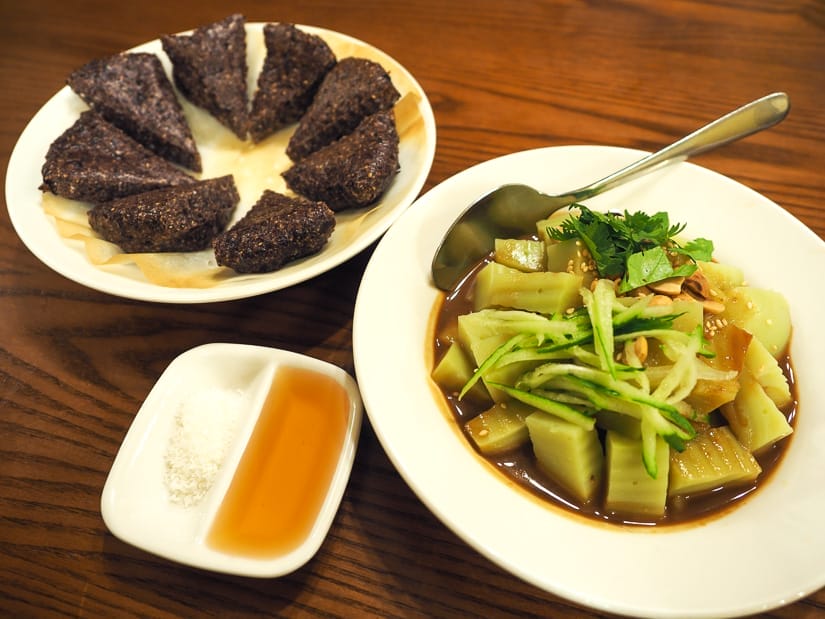
Items on the menu at this restaurant include cold pea jelly with spicy-sour sauce, purple glutinous rice cakes (both vegetarian), bamboo worms (yes, literal worms), pig scalp, twice cooked pork, Yunnanese noodles, chicken soup with papaya, whole steamed fish, and fried mountain cabbage.
I had a borderline scary drive back to Cingjing, with mist and light rain as I tried to navigate the winding road in the dark.
Before returning to my hotel, I had one more attraction to investigate: Swiss Garden (清境農場小瑞士花園). Now, I must say that I have been to some really shitty attractions in Taiwan – whether it was for my kids, because the magazine I was writing for wanted me to, or because I try to visit everywhere for writing about it.
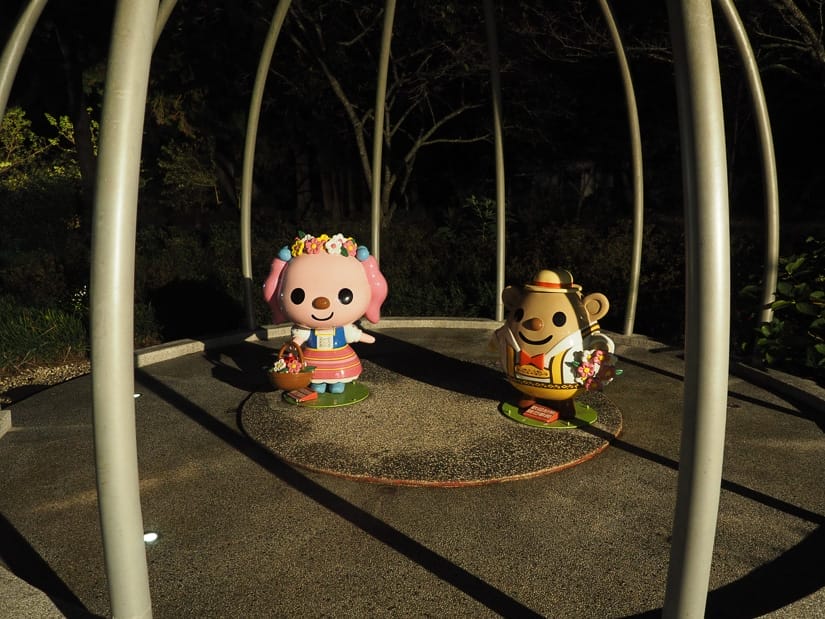
But Swiss Garden actually takes the cake for the worst attraction I’ve ever paid money for in my life. For TWD 150, you get a dirty pond with cement path around it, a few cement pavilions with haphazardly placed lights, and some 7-11 mascot statues.
I can’t even imagine how this place has 4 stars on GoogleMaps with 17,000+ reviews (meanwhile some of the best food stalls in night markets in Taipei somehow only have 2 stars…)
Some Mandarin bloggers said to come here at night for the lights – while it wasn’t even a step up from the lights along the highway. Others said you have to come here for the cherry blossoms in February or fall foliage in November/December.
Well, for those you may even consider it, but for any other time of year, day or night, please don’t waste your money on this! There’s a 7-11 at the parking lot, though, so you want want to go for that. It’s the easiest one to reach if you’re staying in the southern area of Cinging.

The next morning, I was up early and off to Hehuanshan for hiking and staying at Songsyue Lodge. I have nothing but good things to say about there, so visit my Hehuanshan guide for all the details (coming soon!)
Looking back, I’m glad that I checked Cingjing Farm off my list so that I can better advise travelers when they ask me about it. However, it was one of my least favorite places in Taiwan, and that’s saying a lot. I even love Alishan and Sun Moon Lake, which are also super touristy and many people don’t like them.
As soon as I left Cingjing and started driving up to Hehuanshan, my mood improved. I had an amazing time there, even though the weather still wasn’t great. So if Cingjing Farm has but one major plus, it’s that you can stay there for getting to Hehuanshan.

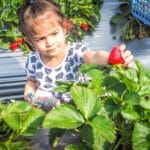
Would you at least recommend Cingjing for a the guesthouse stay? The mountain view from some of the hotel rooms look pretty amazing and unique!
Yes, it’s still a very beautiful area with stunning views and lovely guesthouses. So it’s still worth visiting just for that, if that’s what you’re looking for! I was a little soured by my experience due to poor weather and I didn’t like the farm. I think if the weather was better during my stay, I would have liked it more.